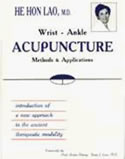I often tell my patients that there are many styles of acupuncture and many theories of how to select the points for a treatment. A person could go to three different acupuncturists and potentially have three completely different treatments that all could very well be effective. As a practitioner, I want to have as many tools of the trade at my disposal as possible. Some techniques may be better suited for children or needle phobic patients. Some systems may be better suited to those who are physically unable to lie on a treatment table for any length of time. Sometimes, a patient just doesn’t respond to a particular approach and it is always nice to have a plan ‘B’.
 Wrist-Ankle Acupuncture (WAA) is a relatively new branch of the acupuncture field. Dr. Xinshu Zhang brought the system into being in Shanghai, China in the 1970’s. It differs considerably from meridian style acupuncture in both theory and needle technique. The best English text on the subject that I am aware of is “Wrist-Ankle Acupuncture, Methods and Applications” written by He Hon Lao, MD. It is an excellent instructional and reference resource. Enough pictures and diagrams are provided of point location and needling considerations, so that with a little practice any acupuncture practitioner could become proficient in the technique.
Wrist-Ankle Acupuncture (WAA) is a relatively new branch of the acupuncture field. Dr. Xinshu Zhang brought the system into being in Shanghai, China in the 1970’s. It differs considerably from meridian style acupuncture in both theory and needle technique. The best English text on the subject that I am aware of is “Wrist-Ankle Acupuncture, Methods and Applications” written by He Hon Lao, MD. It is an excellent instructional and reference resource. Enough pictures and diagrams are provided of point location and needling considerations, so that with a little practice any acupuncture practitioner could become proficient in the technique.
In traditional acupuncture, there are 361 standardized acupuncture points along 14 channels. In WAA there are only six points above the wrist and six points above the ankle. The body is divided into six bilateral longitudinal zones, each one corresponding to one of the wrist or ankle points. Horizontally, the body is divided in half at the xiphoid process. If the disease or symptom occurs above that horizontal line, a wrist point is selected. If below, an ankle point is selected.
The WAA method not only treats pain and numbness in the body, but also treats a variety of internal, psychological, neurological and dermatological disorders. Some of the clinical applications and case studies in the book include migraines, tmj, trigeminal neuralgia, sciatica, back pain, Bell’s palsy, and carpal tunnel. Systemically, protocols are given for such ailments as insomnia, anxiety, bedwetting, and hypertension.
Needles are inserted subcutaneously for about an inch and a half without obtaining any deqi sensation. With proper insertion, the patient feels absolutely no sensation. Because the needles are so superficial, they are often left embedded (securely fixed with a sterile adhesive bandage) for severe or chronic conditions. Needles are often retained for as long as 24 hours.
A couple of years ago, I attended a seminar at Memorial Sloan-Kettering Cancer Center in NYC. WAA was one of the techniques that they recommended to treat cancer pain because the technique utilizes distal points and because the patient can take the treatment home with them.
There have been a couple of interesting articles in the Journal of Chinese Medicine that discuss WAA. An excellent article, entitled “ Wrist And Ankle Acupuncture Therapy” in the September 1991 issue, discusses the technique, theory and applications. Another article, in the October 1999 issue, entitled ”The Treatment of Stress Syndromes By Acupuncture” uses WAA in conjunction with traditional acupuncture points to relieve neck and shoulder tension. Another more recent article, in the February 2006 issue, is entitled ”The Treatment of Chronic Shoulder Pain With Wrist-Ankle Acupuncture”. WAA may be a good alternative for treating back and sciatic pain during pregnancy. And I have colleagues who swear by this technique for Restless Leg Syndrome.
I think WAA is a must for both the practitioner and the serious student of acupuncture to have in their bag of tricks!
About the Author:
Joyce Marley is a licensed acupuncturist that provides acupuncture therapy in New Hartford, NY. She writes Traditional Chinese Medicine (TCM) health articles about acupuncture and Oriental medicine.



